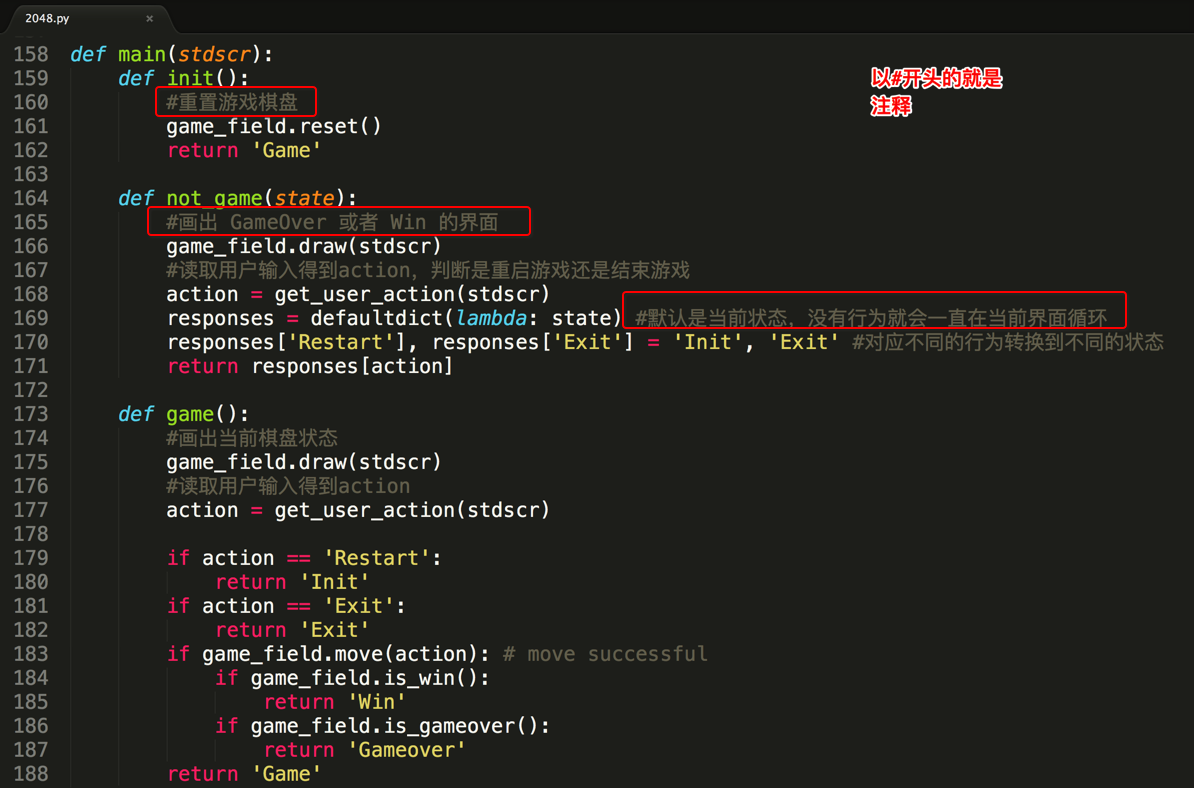## 1\. 注釋的引入
### 1.1. 看以下程序示例(未使用注釋)
](images/screenshot_1593858043332.png)
### 1.2. 看以下程序示例(使用注釋)

### 1.3. 小總結(注釋的概念和作用)
* 注釋:在程序代碼中對程序代碼進行解釋說明的文字。
* 作用:注釋不是程序,不能被執行,只是對程序代碼進行解釋說明,讓別人可以看懂程序代碼的作用,能夠大大增強程序的可讀性。
## 2\. 注釋的分類
### 2.1. 單行注釋
以#開頭,#右邊的所有文字當作說明,而不是真正要執行的程序,起輔助說明作用
~~~
# 我是注釋,可以在里寫一些功能說明之類的哦
print('hello world')
~~~
### 2.2. 多行注釋
~~~
'''
我是多行注釋,可以寫很多很多行的功能說明
下面的代碼完成 ,打印一首詩
名字叫做:春江花月夜
'''
print('╔═╤═╤═╤═╤═╤═╤═╤═╤═╤═╤═╤═╤═╤═╤═╤═╤═╤═╤═╤═╗')
print('║ │ │ │ │ │ │ │ │ │ │ │ │ │ │ │ │ │ │ │ ║')
print('║ │ │ │ │ │ │ │ │ │ │ │ │ │ │ │ │ │ │ │ ║')
print('║ │春│滟│江│空│江│江│人│不│白│誰│可│玉│此│鴻│昨│江│斜│不│ ║')
print('║ │江│滟│流│里│天│畔│生│知│云│家│憐│戶│時│雁│夜│水│月│知│ ║')
print('║ │潮│隨│宛│流│一│何│代│江│一│今│樓│簾│相│長│閑│流│沉│乘│ ║')
print('║ │水│波│轉│霜│色│人│代│月│片│夜│上│中│望│飛│潭│春│沉│月│ ║')
print('║ │連│千│繞│不│無│初│無│待│去│扁│月│卷│不│光│夢│去│藏│幾│ ║')
print('║春│海│萬│芳│覺│纖│見│窮│何│悠│舟│徘│不│相│不│落│欲│海│人│ ║')
print('║江│平│里│甸│飛│塵│月│已│人│悠│子│徊│去│聞│度│花│盡│霧│歸│ ║')
print('║花│,│,│,│,│,│,│,│,│,│,│,│,│,│,│,│,│,│,│ ║')
print('║月│海│何│月│汀│皎│江│江│但│青│何│應│搗│愿│魚│可│江│碣│落│ ║')
print('║夜│上│處│照│上│皎│月│月│見│楓│處│照│衣│逐│龍│憐│潭│石│月│ ║')
print('║ │明│春│花│白│空│何│年│長│浦│相│離│砧│月│潛│春│落│瀟│搖│ ║')
print('║ │月│江│林│沙│中│年│年│江│上│思│人│上│華│躍│半│月│湘│情│ ║')
print('║ │共│無│皆│看│孤│初│望│送│不│明│妝│拂│流│水│不│復│無│滿│ ║')
print('║ │潮│月│似│不│月│照│相│流│勝│月│鏡│還│照│成│還│西│限│江│ ║')
print('║ │生│明│霰│見│輪│人│似│水│愁│樓│臺│來│君│文│家│斜│路│樹│ ║')
print('║ │。│。│。│。│。│?│。│。│。│?│。│。│。│。│。│。│。│。│ ║')
print('║ │ │ │ │ │ │ │ │ │ │ │ │ │ │ │ │ │ │ │ ║')
print('║ │ │ │ │ │ │ │ │ │ │ │ │ │ │ │ │ │ │ │ ║')
print('╚═╧═╧═╧═╧═╧═╧═╧═╧═╧═╧═╧═╧═╧═╧═╧═╧═╧═╧═╧═╝')
~~~
### 2.3. python程序中,中文支持
python3中,是默認支持中文的,但是在python2中就需要一定的額外操作才可以
python2中,如果直接在程序中用到了中文,比如
~~~
print('你好')
~~~
如果直接運行輸出,程序會出錯:

解決的辦法為:在程序的開頭寫入如下代碼,這就是中文注釋
~~~
#coding=utf-8
~~~
修改之后的程序:
~~~
#coding=utf-8
print('你好')
~~~
運行結果:
~~~
你好
~~~
#### 注意:
在python的語法規范中推薦使用的方式:
~~~
# -*- coding:utf-8 -*-
~~~
- 計算機組成原理和Python基礎知識
- 計算機組成原理
- 編程語言和Python
- 開發第一個Python程序
- 注釋
- 變量以及類型
- 標識符和關鍵字
- 輸出
- 輸入
- 運算符
- 數據類型轉換
- 判斷語句和循環語句
- 判斷語句介紹
- if語句
- 比較、關系運算符
- if...else...語句格式
- if...elif...else語句格式
- if語句的嵌套
- if應用:猜拳游戲
- 循環語句介紹
- while循環
- while循環應用
- while循環的嵌套以及應用
- for循環
- break和continue
- 字符串、列表、元組、字典
- 字符串介紹
- 字符串輸出
- 字符串輸入
- 下標和切片
- 字符串常見操作
- 列表介紹
- 列表的循環遍歷
- 列表的常見操作
- 列表的嵌套
- 元組
- 字典介紹
- 字典的常見操作1
- 字典的常見操作2
- 字典的遍歷
- 集合(擴展)
- 公共方法
- 4.函數(一)
- 4.1.函數介紹
- 4.2.函數定義和調用
- 4.3.函數的文檔說明
- 4.4.函數參數(一)
- 4.5.函數返回值(一)
- 4.6.函數的嵌套調用
- 4.7.函數應用:打印圖形和數學計算
- 5.函數(二)
- 5.1.局部變量
- 5.2.全局變量
- 5.3.多函數程序的基本使用流程
- 5.4.函數返回值(二)
- 5.5.函數參數(二)
- 5.6.拆包、交換變量的值
- 5.7.引用(一)
- 5.8.可變、不可變類型
- 5.9.引用(二)
- 5.10.函數使用注意事項
- 6.強化練習
- 6.1.函數應用:學生管理系統
- 6.2.遞歸函數
- 6.3. 匿名函數
- 6.4.列表推導式
- 6.5.set、list、tuple
- 6.6.高階函數: map reduce filter
- 7.文件操作,綜合應用
- 7.1.文件操作介紹
- 7.2.文件的讀寫
- 7.3.應用1:制作文件的備份
- 7.4.文件的相關操作
- 7.5.應用:批量修改文件名
- 7.6.綜合應用:學生管理系統(文件版)
- 8.面向對象(上)
- 8.1.認識面向對象編程
- 8.2.類和對象
- 8.3.定義類
- 8.4.創建對象
- 8.5.添加和獲取對象的屬性
- 8.6.在方法內通過self獲取對象屬性
- 8.7.魔法方法 - init()
- 8.8.魔法方法 - 有參數的__init__()方法
- 8.9.魔法方法 - str()方法
- 8.10.魔法方法 - del()方法
- 8.11.實操案例 - 烤土豆
- 9.面向對象(中)
- 9.1.實操案例 - 放家具
- 9.2.繼承的概念
- 9.3.單繼承
- 9.4.多繼承
- 9.5.子類重寫父類的同名屬性和方法
- 9.6.子類調用父類同名屬性和方法
- 9.7.多層繼承
- 9.8.通過super()來調用父類的方法
- 10.面向對象(下)
- 10.1.私有屬性和私有方法
- 10.2.修改私有屬性的值
- 10.3.多態
- 10.4.類屬性和實例屬性
- 10.5.靜態方法和類方法
- 11.異常處理與模塊初識
- 11.1.異常
- 11.2.捕獲異常
- 11.3.異常的傳遞
- 11.4.拋出自定義的異常
- 11.5.獲取異常完整信息的正確姿勢
- 11.6.認識模塊
- 11.7.開發模塊
- 11.8.模塊中的__all__(未完成)
- 11.9.python中的包(未完成)
- 12.課后加餐
- 12.1.基礎應用 - 進銷存管理系統(未完成)
- 12.2.基礎應用 - 員工信息管理系統(未完成)
- 12.1.編碼規范 - PEP8編碼規范(未完成)
